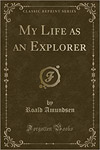The Race to the Pole - 1911-1912
Roald Amundsen and Robert
Scott
Terra Nova Expedition: The pole - p.1 - Preparations | The pole p.2 - Journey | The wider Terra Nova expedition | Time-line and info graphic | Crew of the Terra Nova | What went wrong for Scott to die? | What did Scott's team die of? | Race to the pole Amundsen and Scott | The Northern Party
The attainment of the South Pole by Roald Amundsen ahead of Robert Scott has frequently described Amundsen as the winner in a race. Over a hundred years later there is still debate about the events, how well the two men were prepared, how they conducted themselves, what role luck had to play and not least of their legacies. They both led five man teams to the pole, though while Amundsen's team returned alive and well, Scott's party all died on the return journey.
What has become known as the Race to the South Pole came about incidentally rather than by design. At no time did Amundsen and Scott acknowledge or plan for a race, they both planned expeditions that had as an ambition to be the first man to reach one of the last great geographic goals of the age, the South Pole.
There was controversy almost from the outset, Scott set off thinking his would be the only party in Antarctica with an ambition of reaching the South Pole at that time. Amundsen was to try for the North Pole but changed his plans when he heard that Americans Cook and Peary had claimed to have reached there, fearing he would be financially ruined (not even telling his own crew until they were headed south) and so set the scene unilaterally for a "race". Amundsen returned home in triumph and was well received on lecture tours describing his achievement, this was soured when months later the news arrived that Scott and his party had also reached the South Pole but had all perished on the way back. Somewhat ironically Scott and his party became the heroes of the piece, Scott himself being held as a major national hero in Britain, while Amundsen not actually seen as the villain, was passed over for further acclaim.
The hailing of Scott as the most noble kind of national hero continued almost without question for more than half a century until his failings began to be pointed out and his story began to attract criticism towards the end of the 20th century.
Amundsen found life difficult on his return, he was wounded by accusations of unsporting conduct in the manner that he arrived in Antarctica to "race" Scott to the pole without giving any prior notice of intention, these accusations were all the more painful because he and his team survived while Scott and his party all perished. He died in 1928 in what was assumed to be an airplane crash in the Arctic after wreckage but no bodies were found.
Many lessons were learned about exploration in the Antarctic from both Amundsen and Scott from successes and failures that would be invaluable for future expeditions. Their stories are fascinating for many reasons and reveal them as complex characters affected by a whole host of factors, the way they were received by the world and their countries is almost as complex. Perhaps the greatest compliment to both of them is that there is now a large scientific station at the South Pole manned year round called the Amundsen-Scott South Pole Station.
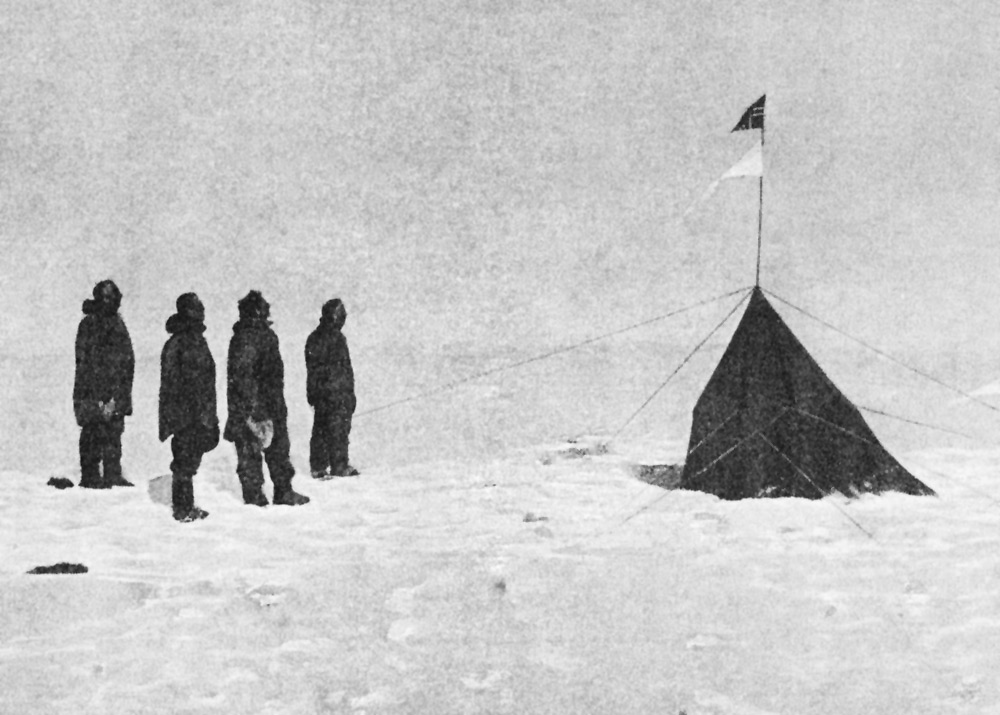 Amundsen
and his party at the South Pole, 14th December 1911,
Friday, about 3 p.m.
Amundsen
and his party at the South Pole, 14th December 1911,
Friday, about 3 p.m.
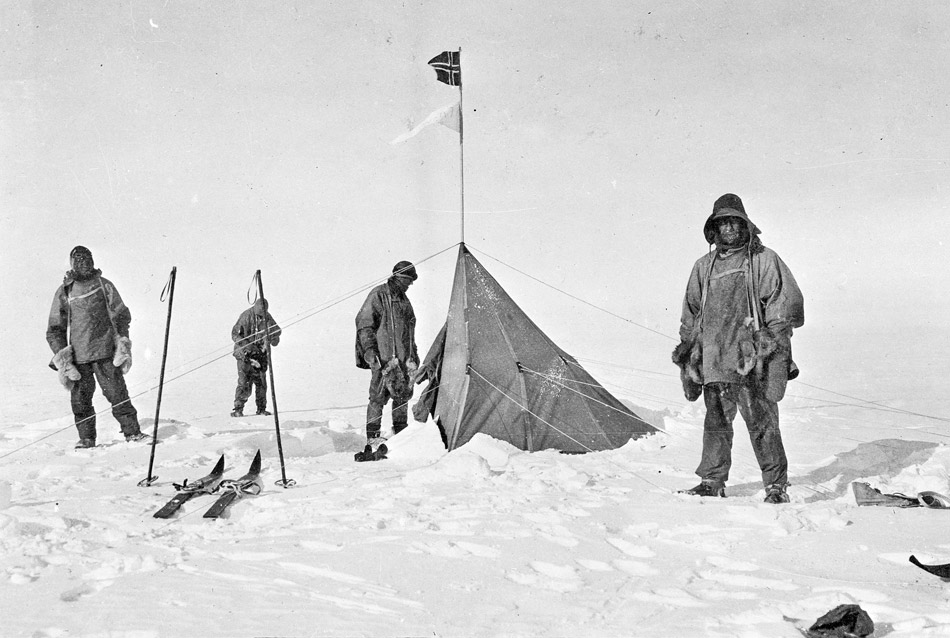
Scott and his party at the South Pole
by the Norwegians tent, 18th January, 1912
A comparison of Amundsen and Scott in relation to preparations to reach the South Pole and afterwards. Who "won" is clear, though only if you consider there was a competition.
Amundsen's story Scott's story
Amundsen
Prior experience:
- 2 years on the Belgica expedition to Antarctica, 1897-1899
- 3.5 years sailing the North-West passage in the Gjoa, 1903-1906
- Much experience in the Arctic using dog sleds and skis. At the age of 21 he abandoned his studies to be a doctor when his mother died and instead pursued a life of polar exploration.
Background
to the South Pole attempt:
Amundsen
was given the ship Fram by Fritjof Nansen to
attempt to drift across the North Pole, he paid for
supplies and wages by asking others for financial backing.
In September 1909, American Robert Peary claimed to
have reached the North Pole, Amundsen's plans were
ruined and he may have been personally financially ruined
as a result if he couldn't deliver a success.
He changed his plans and headed to the South Pole instead without telling his backers or making it public until he was well under way in case the project was ended before it begun. The captain of the Fram was told in advance and two other men were told on the day of departure, the rest of the crew were not told until the Fram had sailed south to Madeira supposedly for oceanographical research. Amundsen claimed that he thought Scott's expedition was scientific only with the Pole being a side issue, despite Scott making a public announcement nearly a year earlier about an attempt on the Pole.
Aims of the Expedition:
- To be the first party to reach the South Pole.
- Scientific complement = 0
The route:
Started at the Bay of Whales, 60 miles
closer to the pole than Scott, with no scientific programme
no compromise needed to be made. More of the journey
distance was made over the Ross Ice Shelf meaning that
less of the journey was at the altitude of the Polar
Plateau, the men would function more efficiently for
longer and be subjected to colder high altitude temperatures
for a shorter time. Access to the Polar Plateau was
made by going up a glacier discovered by Amundsen and
called the Axel Heiberg Glacier after one of his patrons.
Amundsen and his team had chosen not to go the known
Beardmore glacier route as that was Scott's and "out
of bounds". The route up to the plateau involved
much gain and loss of height (19,590 feet v Scott's
11,470 feet) it has been said that it is easier to make
this journey with a dog team which would have much greater
difficulty on the Beardmore, though subsequent assessment
has found this route is very difficult in itself, only
a very skilled and experienced team of handlers could
attempt it.
Scott
Prior experience:
- 3 years as leader of the Discovery Expedition to Antarctica, 1901-1904. Of 50 men on the expedition hardly any had any polar experience, there was very little prior or ongoing training to use equipment or techniques such as dog sledding or skiing.
- An officer in the British Navy seeking advancement partly due to reduced family circumstances, in "The Voyage of the Discovery" he wrote: "I may as well confess that I had no predilection for polar exploration".
Background to
the South Pole attempt:
Scott returned
to Britain a hero after the Discovery expedition, he
resumed his naval career now promoted to captain. On
the Discovery he had fallen out with Ernest Shackleton
who was by 1906 planning his own Antarctic expedition.
Scott felt Shackleton had no claim to go to the McMurdo
area as he had prior "right" to this sector.
Scott was very much the establishment man and was chosen to head the official British Antarctic Expedition, Scott stated that the main objective was "to reach the South Pole, and to secure for the British Empire the honour of this achievement". Scott arranged for ponies, dogs and motor sleds to be purchased though still favoured manhauling as did his backers in the navy. Regardless of preference, it was thought that motor sleds, dogs and ponies would not be able to ascend the highly crevassed Beardmore Glacier, the route pioneered by Shackleton in 1909. While other means could be used to lay depots, they would have to manhaul to the pole.
Aims of the Expedition:
- To be the first party to reach the South Pole, stated by Scott as being the main aim.
- A large and wide ranging programme of
scientific measurements, experimentation and discovery.
Scientific complement = 12
The route:
Scott made his base at Cape Evans on
Ross Island a more suitable base for scientific explorations
though further from the pole and subjected to sea ice
melting or forming dictating when the start/end of the
journey could be attempted. The route he was to take
was that pioneered by Shackleton during his 1907-1909
expedition, reaching the Polar Plateau along the active
Beardmore Glacier which was very broken up and crevassed,
slowing progress. Unlike Amundsen's access to the
Plateau via the short and steep Axel Heiberg Glacier
this was a long slow climb that should have been easier
for dogs, ponies and motor sleds, though was actually
worse due to its broken up nature with crevasses and
ice-falls. Scott's journey was longer and he spent
more time at the altitude of the Polar Plateau with
its thinner air and colder temperatures.
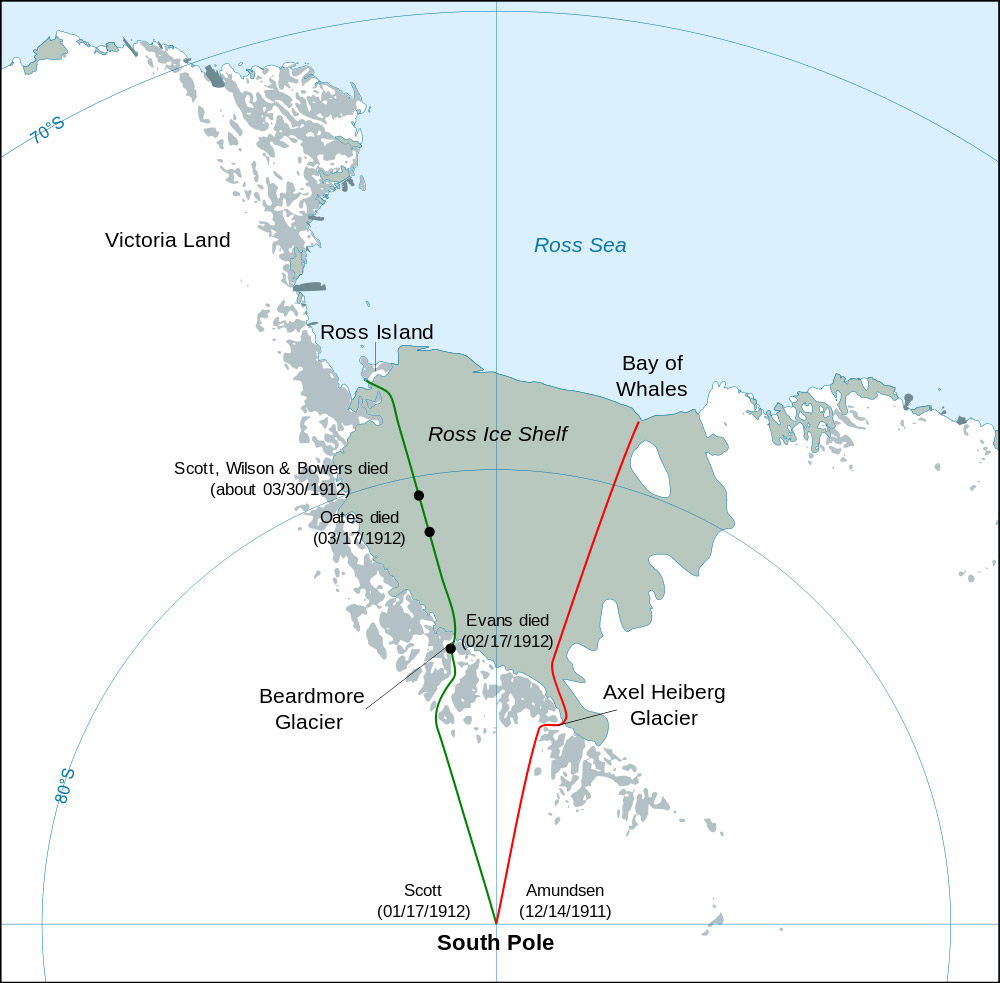
Amundsen
Means of Transport:
Amundsen had much experience
with sled dogs during his trip in the Gjoa across the
Northwest Passage, he had lived with and learned
much from the Inuit about how to use them and what were
their strengths and weaknesses. Norwegians at the time
tended to use reindeer as pack animals.
His plan with the dogs was to use many of them in the early part of trip with heavy loads and to get up onto the Polar Plateau, to then kill them and use them to feed the men and other dogs in the later part of the journey. Once up on the Polar Plateau, 24 dogs were killed out of 52 taken, only 11 returned alive. All of the Norwegians could ski well, Olav Bjaaland was recruited to the expedition on his strengths as a champion skier. The speed of the dogs and skiers meant that longer periods of rest were possible.
Weather:
There is evidence that Amundsen in leaving
and returning earlier than Scott avoided unusually severe
weather that year that Scott and his team walked right
into.
Food and Fuel:
Amundsen's team actually gained
weight during the journey to the pole, partly due to
the extra food available from the dogs that were killed
along the route.
Amundsen was particularly fastidious in marking the route during the depot laying preparations meaning that his team could travel even in poor visibility conditions, they had more frequent food depots, Amundsen depoted three times the amount of food that Scott did. The paraffin fuel used for the stoves "creeps" in cold temperatures, that is, it leaks out of the screw top to the can and evaporates, Amundsen made sure all fuel cans were also soldered closed until they were to be opened leading to no fuel losses. The sledging rations Amundsen took included oatmeal and pemmican with peas in, this would have given them vitamins that would have helped prevent scurvy.
Clothing:
The Norwegians took Inuit style clothing
made entirely out of furs, another thing Amundsen learned
from his Gjoa expedition.
They were worn loose to allow for the loss of sweat during exertion meaning that it didn't then freeze inside the clothing when at rest.
Scott
Means of Transport:
Scott has been much criticized for his
transport choices. While he took motor sleds, ponies,
dogs and an expert skier Tryggve Gran, to teach his
men to ski, each of these was poorly used. The largest
of the three motor sleds was lost while being taken
ashore, the remaining two were unreliable and Skelton
the expert in their use, was left behind for reasons
of naval rank protocols in the South Pole journey, the
remaining two sleds failed and could not be fixed. The
ponies had snow shoes to stop them sinking in soft snow
but they were not used so severely limiting their usefulness.
Not enough of the men were expert enough with the dogs
to be effective and there were insufficient dogs in
the first place. Finally while Scott encouraged his
men to learn to ski, they were reluctant and he did
not insist on them learning. He was left with the most
exhausting and slowest method of manhauling, though
he considered this to be more "noble".
Weather:
Weather records show that the weather
on the return journey for Scott was particularly bad,
being a one in fifteen year temperature lows, by that
time Amundsen had returned.
Food and Fuel:
Theoretical measurements and practical
modern experimentation has shown that Scott's team
had insufficient food for their needs, they were all
in quite a poor state by the time they reached the Pole.
Calculations had been made by Scott, but he was not
aware of the greater need for food while manhauling
at the altitude of the Polar Plateau and so underestimated
how much was needed. Scott ignored the phenomenon of "fuel
creep" loss from the paraffin cans even though
it was well known, consequently his team were short
of fuel possibly also leading to dehydration as less
snow could be melted for water to replace the deceptively
large amount lost when exercising at low temperatures.
They were almost certainly also suffering from the debilitating
effects of scurvy too due to the lack of vitamins in
their sledging rations. The ponies were killed for food
when they had outlived their usefulness, like Amundsen's
dogs.
Clothing:
Scott's men had woolen underwear
with windproof outer layers, this layer system is good
and is used today, there was a problem with allowing
for sufficient ventilation during exertion meaning that
sweat froze in the clothes making them hard and stiff,
especially after a camp.
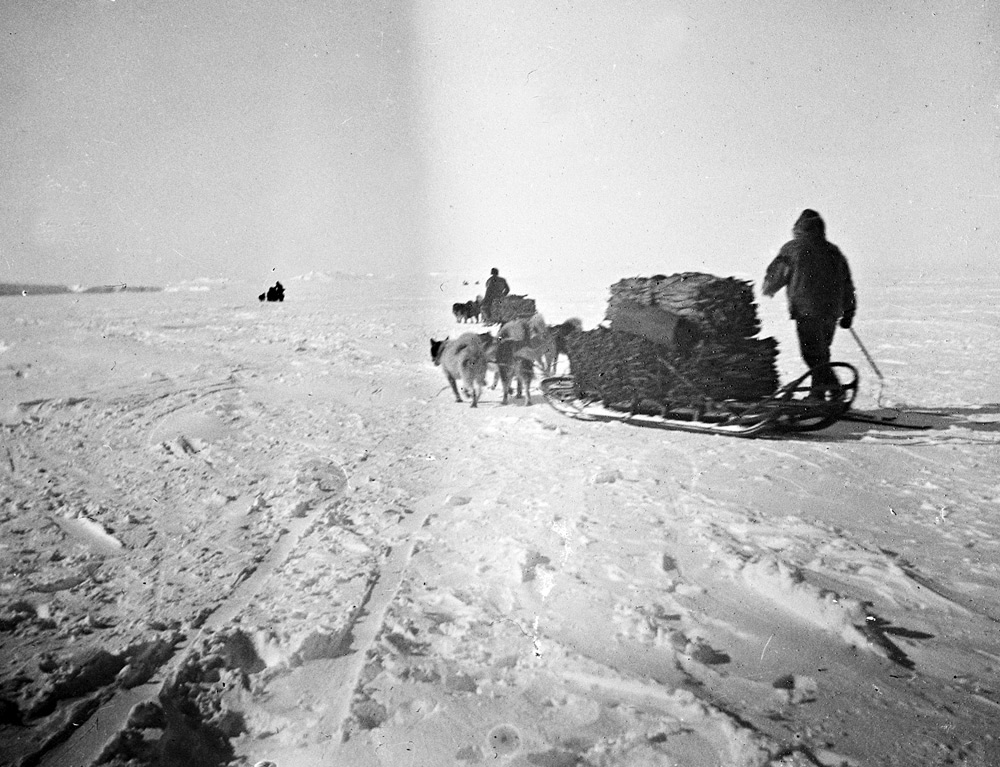 Amundsen's
party on a provisioning run with dog sleds
Amundsen's
party on a provisioning run with dog sleds
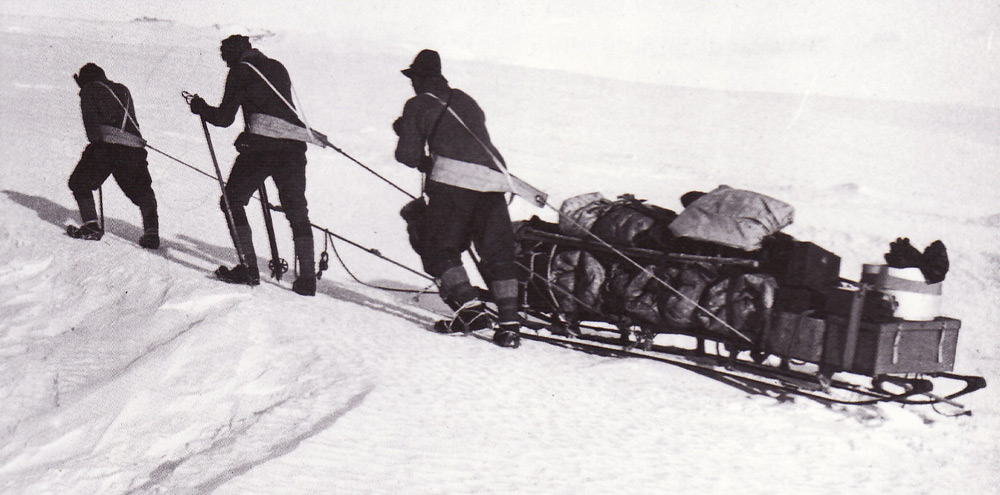 Scott's
party manhauling supplies
Scott's
party manhauling supplies
Amundsen
First attempt,
8th September 1911:
Amundsen was concerned
by the possibility that Scott's motor sledges would
allow him to reach the pole first and wanted to set
off as soon as possible after the sun rose again in
late August. Against the advice of the very
experienced Hjalmar Johansen that it was too cold, he
set off on the 8th of September 1911 with eight of the
nine men on his expedition. Day time travel was good
and they made good progress in the first few days despite
very cold temperatures, it was so cold at night however
that they could hardly sleep and some of the dogs suffered
from frostbitten paws. By the 12th of September with
temperatures of -56C they stopped and built igloos for
shelter before returning to the ship to try again later.
Some of the dogs froze to death on the way back, others
too weak to run were placed on the sledges, Amundsen
ordered his men to push for home as soon as possible
rather than travelling as a group. Amundsen and two
others arrived back first after nine hours, another
sledge two hours later and the final two including Johansen
over seventeen hours after setting off. Johansen answered
Amundsen's question about why they had been so late
angrily, feeling they had been abandoned without food
or fuel and suffering from frostbite. Amundsen later
reported that he felt Johansen was "violently subordinate"
and excluded him from the South Pole party.
Second attempt,
19th October 1911:
Amundsen
set out again with five men, four sledges and fifty
two dogs. Once again they made good progress,
though Amundsen deliberately avoided the Beardmore Glacier
route that Scott would take to get from the near sea-level
ice shelf and onto the Antarctic Plateau, he found a
steep and difficult but direct route up a small glacier
he named after Axel Heiberg, one of his financial backers.
seven of his dogs had died on the ice barrier to reach
the glacier, all but a remaining eighteen were killed
at the top of the glacier, the carcasses were eaten
eagerly by the dogs and men alike, some were depoted
to be picked up on the return journey. They
reached the pole on the 14th of December 1911, 56 days
after setting off.
They stayed in the vicinity of the pole before setting off on their return journey on the 18th. During this time, they took navigational readings at different times of the day and travelled in the vicinity to make sure they really had reached the South Pole. Amundsen left a tent and a letter addressed to the King of Norway with a request to Scott to deliver it. They arrived back at the Fram on the 25th of January 1912, just 38 days after leaving the south pole. The whole trip had taken 99 days, 10 less than anticipated, they had covered 3,440km (1,860 nautical miles), five men and fifty two dogs had set off, five men and eleven dogs had returned.
Scott
Scott left his camp with men travelling with motor sledges, dogs, ponies and on foot on the 1st of November 1911. Only a small party of four would go all the way to the pole, the others were there to help transport food and supplies to be used on the outward journey and left at supply dumps to be used by the pole group on the way back again. The ponies were killed during this march, some of the meat eaten and some of it depoted as Amundsen did with his dogs. Eventually there were two teams each of four men manhauling sledges and provisions, though he had planned for four, Scott decided to take a five man party to the pole including himself, the remaining three turned back to the ship. Scott's party arrived at the pole on the 17th of January 1912, 77 days after setting off.They found that Amundsen had beaten them by five weeks, their condition was deteriorating by this time due to an insufficient diet in quantity and nutrient quality, scurvy was probably beginning to take effect. They rested for a day and set off to return on the 19th. Despite unusually cold weather, their diet and low morale, they made good progress to the edge of the polar plateau. During the 100 mile descent of the Beardmore Glacier from the plateau down to near sea level one of the party, Edgar Evans suffered a fall on the 4th of February that left him "dull and incapable", he never really recovered and fell again on the 17th of February dying near to the foot of the glacier.
Scott had left orders for dog teams to meet the polar party at 82.30S about the 1st of March 1912, the remaining four men reached this point by the 27th of February. By the 10th of March they gave up on seeing the dogs arriving, they had about 400 miles left to go in difficult surface conditions and unusually cold temperatures. On this day Captain Lawrence Oates with badly frostbitten feet walked out from the tent in a blizzard to his death, his last reported words were "I am just going outside and may be some time". They walked another 20 miles, all suffering badly now and made their final camp on the 19th of March. Blizzards prevented further progress and they stayed in their tent with dwindling supplies, Scott's final diary entry was on the 29th of March, he is thought to have been the last to die on this or the next day, 70 days after leaving the pole. Their last camp was just 11 miles (18km) short of "One Ton Depot" where food and fuel could have saved them.
The three bodies in the tent were not found until eight months later on the 12th of November 1912. A large cairn of snow was erected over the tent and a makeshift cross erected. Before the Terra Nova left for home a memorial cross was erected on Observation Hill overlooking Hut Point, the cross is there today still.
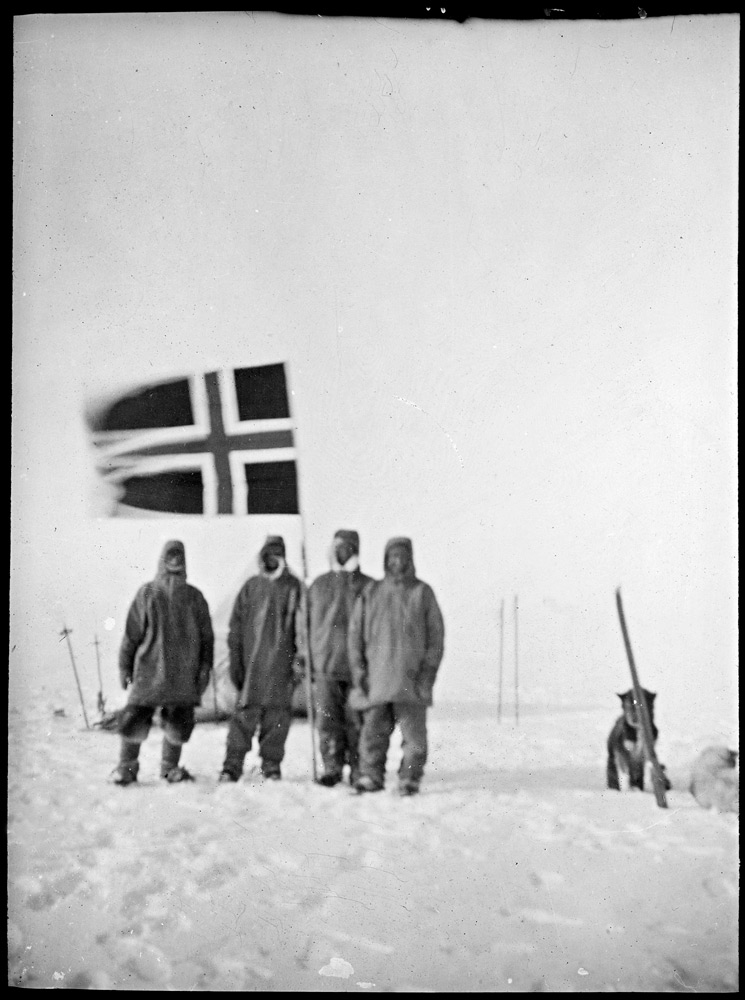 Amundsen's
party at the pole
Amundsen's
party at the pole
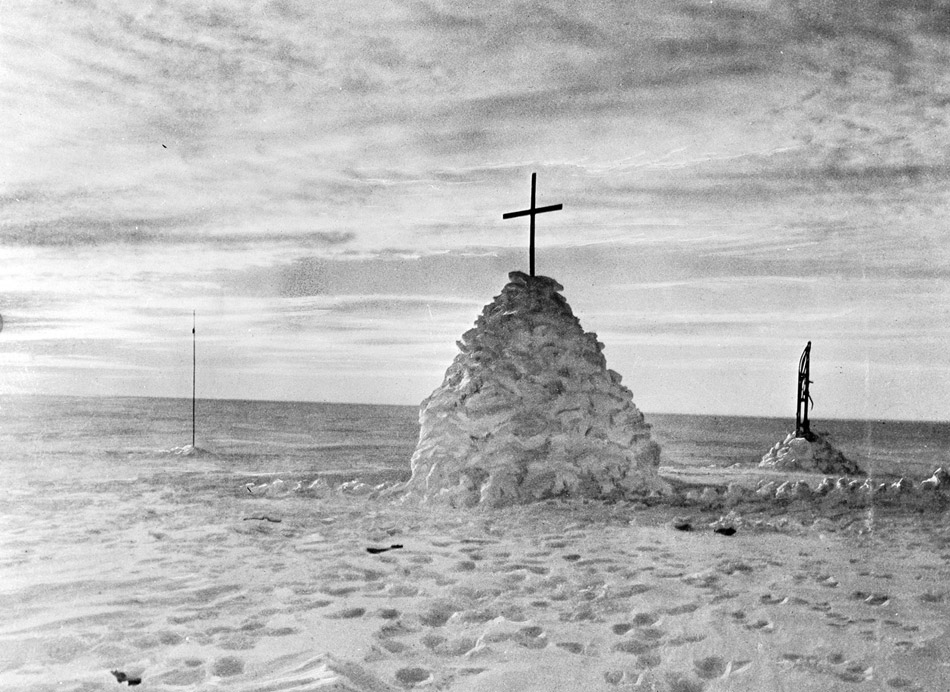
Cairn marking the site of Scott's
tent and final camp
Amundsen
The next year:
Amundsen was keen to get back
to civilization as soon as possible to announce his
achievement to the world. The Fram sailed north
and on March the 8th 1912 reached Hobart, Australia
from where he cabled his brother with the news and made
a public announcement. He was lecturing under the title "How
we reached the Pole" in Sydney, Australia less
than a month later at the beginning of April 1912 and
proceeded to a lecture tour of Britain under the same
title. By the time the news of Scott broke, the following
February, he was in the USA giving the same lectures
under the heading "Discoverer of the South
Pole and Winner in the International Race for the Southern
Extremity of the Earth". In a time before tv and
radio, lecture tours were the means by which explorers
and others could make money from their expedition by
bringing them to the general public and pay back the
debts incurred, all Heroic Age explorers did this.
On August the 20th 1912, all of the crew of the Fram who were with Amundsen were awarded the "South Pole Medal" by King Haakon of Norway a modified version of the existing honour the "Kings Medal of Merit".
Amundsen was widely regarded as acting in an ungentlemanly way in the way that he had decided to "race" Scott to the Pole when his North Pole ambitions had been thwarted, especially as he had planned for the south for about a year while keeping it a secret from almost all the interested and involved parties any one of whom may have pulled out of his changed plans had they known. He was seen as unsportingly playing a game for his own ends. There was little worse that a gentleman could be accused of in Edwardian Britain or indeed the wider world at the time. At a meeting in London to honour his Polar success, the Royal Geographical Society president called for "Three cheers for the dogs!".
The next fifteen
years:
The South Polar trip
rendered Amundsen financially solvent again and enabled
him to invest in a shipping business which did well
during the war years. He remained dedicated
to polar exploration involving himself in an unsuccessful
attempt to drift over the north pole in a ship in 1918.
After this, he become interested in flying and trying
to reach the North Pole by aeroplane, though again without
success. In 1926 along with American Lincoln Ellsworth
and Italian Umberto Nobile he successfully drifted over
the North Pole in an airship from Spitsbergen, Norway
to Alaska. The claims to have reached the North Pole
by Cook (1908) and Peary (1909) have both been disputed,
in the case of Cook it is widely accepted that he did
not do so, in the case of Peary it is likely though
not proven that he did not. If Peary did not reach the
North Pole, this makes Amundsen part of groups to have
reached both the south and the north poles for the first
time.
Roald Amundsen died with a crew of five in a small flying boat that took off from Tromso, Norway in June 1928 on a rescue mission for Nobile and two others whose airship had crashed on the way back from the North Pole. While wreckage from the plane was found, no bodies were ever recovered.
Amundsen took the criticism of the manner in which he became first to the South Pole badly. It is said that he was much troubled by the fact that Scott and his men died, though Amundsen's actions had no actual impact or influence on Scott's men. He was described as unhappy and that he felt the rest of his life to be an anti-climax, he didn't receive the same adulation or financial security that his mentor Nansen had done, even though Amundsen's achievements eclipsed Nansens'.
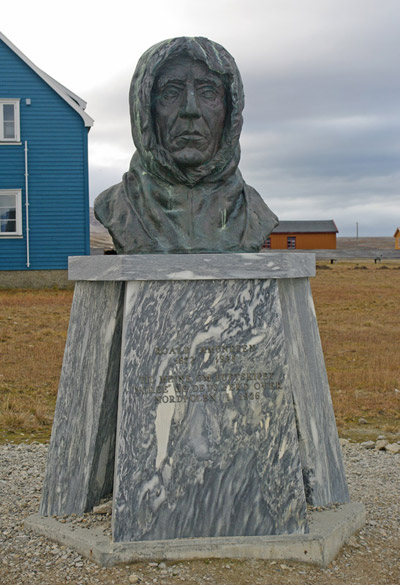
Bust of Roald Amundsen at Ny Alesund,
Svalbard from where he left to drift across the North
Pole by airship in 1926
After Amundsen's
death:
The "Fram
Museum" was opened in Oslo, Norway in 1936
to house the Fram and tell the story of her
voyages, of which Amundsen's South Polar trip was
only one. In 2013, the Fram was joined by the
Gjoa, the ship that Amundsen and five others
spent three and a half years sailing through the Northwest
passage in from 1903-1906.
Still Amundsen was overlooked for many years, largely being in the shadow of Scott, it was only when the Scott myth began to be questioned from the late 1960's onwards that Amundsen was able to emerge into the light somewhat, even in his native Norway. Not until the 100th anniversary of reaching the pole, the 14th of December 2011 was a South Pole monument to Amundsen and his party unveiled in Oslo, the Norwegian capital. It consists of life-sized bronze statues of the five men standing on granite slabs based on a photo taken of them while standing at the South Pole.
Literature and
photography:
Amundsen was not possessed
of any great literary talent and his accounts in his
diary are quite matter of fact and not especially readable
or evocative of time or place. This will have contributed
to his story fading from view rather than being kept
alive as a thrilling tale.
Amundsen's camera broke quite early into the South Polar trip and most of the pictures that survive were taken by Olav Bjaaland who had his own camera with him. He was not a skilled photographer and many of the pictures are quite poor in composition and also probably in exposure and processing. The photos that remain are mostly either of prints made from the original negatives (now lost ) or of poorly preserved and often cracked and otherwise damaged glass lantern slides. The pictures I have posted on this website of the Amundsen Expedition for instance are nearly all cropped to leave out the worst damage and have sometimes required significant correction to horizontals, to exposure, fading, cracks, speckles and so on. Those from Scott's expedition on the other hand are largely as taken and are much better compositions, many of them still exist as exhibition quality negatives and prints. Again, an important factor in getting the story out.
Family:
Amundsen was never married and had no
children. He was shortly to be married when he went
missing at the age of 55 in 1928.
In his own words:
I may say that this is the greatest factor - the way in which the expedition is equipped - the way in which every difficulty is foreseen, and precautions taken for meeting or avoiding it. Victory awaits him who has everything in order - luck, people call it.
Defeat is certain
for him who has neglected to take the necessary
precautions in time; this is called bad luck.
- Roald Amundsen.
Scott
The next year:
10th February 1913, the news
of Scott's team reaching the pole and their deaths
is released when the Terra Nova reaches Oamaru in New
Zealand. Scott became a national icon in Britain
within a matter of days of the news arriving, a huge
memorial service led by the King was held at St. Paul's
Cathedral in London four days later on the 14th of February.
Scott and his men were held as national heroes having
paid the ultimate price for their endeavour and courage.
The attitude was somewhat of its time, today the attitude
would perhaps be more of a tragedy with lessons to be
learned and less heroic adulation.
The rest of the expedition members were feted on their return with medals and promotions, Scott's wife, Kathleen was honoured in accordance with now being a widow of a man who would have been further honoured had he been alive, becoming Lady Scott.
Scott had written in his diary "...surely, a great rich country like ours will see that those who are dependent on us are properly provided for." This led to a public appeal that raised £75,509 (over £7 million in 2023 equivalent). This was used to pay off over £30,000 of debt owed by the expedition with the remainder distributed to the families of the five men who died, though in a very uneven manner according to their rank. Scott's family received the largest sum of about twelve times as much as that of Evans, the least senior of the men in naval rank terms. £12,000 that remained was given to Cambridge University to found the Scott Polar Research Institute.
The next fifty
years:
Dozens of public monuments
were erected to Scott around Britain in the following
years and also in other parts of the world.
Following the great losses of the First World War, Scott
represented a simpler, more straightforward sort of
hero in the public psyche.
In 1922 "The Worst Journey in the World" by Apsley Cherry-Garrard was published. Cherry-Garrard was one of the men who discovered the bodies of Scott, Wilson and Bowers in November 1912, this helped to keep Scott in the public eye as a national hero.
The Scott Polar Research Institute (SPRI) was established as part of the University of Cambridge as the national memorial to Scott and his men and officially opened in 1926 with Frank Debenham a geologist on the Terra Nova Expedition as its first director. It is still in existence and has around 60 personnel, academic, research and support along with the world's finest polar library and archives. It is regularly used to research contemporary and historical polar matters including by myself for this website. Attached to the library is an important polar museum that contains many original articles from Scott's expedition including diaries, letters and equipment.
Scott's reputation was further upheld in the 1948 film "Scott of the Antarctic" with an original music score written by Ralph Vaughn Williams that he later developed into his 7th symphony, "Sinfonia Antarctica". The film brought the story alive again to a whole new generation.
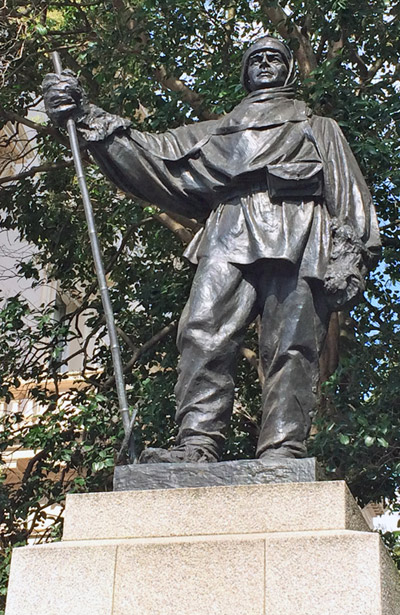
Statue of of Scott in London, there is
a copy of this but in white marble in Christchurch New
Zealand
Reputation reconsidered:
In the late 1960's access was allowed
to Scott's original sledging journal, the Scott
family had prevented access previously which had helped
maintain his reputation. Slowly the details of failings
of preparation and of leadership emerged resulting in
a change of tack by some biographers perhaps eager to
gain fame and notoriety of their own whereby Scott could
hardly do anything right at all. In recent years since
the turn of the 21st century, Scott's reputation
has seen something of an increase in fortunes once again
as he is seen more in context with his time and as more
rounded and human rather than as being held as the man
who led to his own demise and that of the men who entrusted
their lives to him.
Literature and
photography:
One of Scott's trump
cards in becoming the world's most famous Antarctic
explorer over Amundsen was his literary ability, he
was very good with the written word whereas Amundsen
wasn't. Add to that the fact that Scott was writing
the language that most would read him in, with an idea
that he was writing for the consumption of the wider
world, whereas Amundsen was much more a of a workaday
lister of events in a foreign language for most people,
so requiring translation. It becomes clearer how Scott's
reputation could grow while Amundsen's never really
took off to the same extent.
Scott took along the professional photographer and cinematographer Herbert Ponting to document the expedition in a professional manner. Ponting is to my mind the very best of the early photographers to go to Antarctica. Even with the relatively recent at the time invention of smaller and more compact cameras that took photographic film, Ponting still used large cumbersome wood-cased glass plate cameras for much of his photography and produced some images that were exquisite in terms of composition and perfect in the technical matters of exposure and processing to get the most from the negative. Ponting's pictures are the finest from the Heroic Age.
Family:
Scott was married to sculptress and
socialite Kathleen Bruce in 1908. They had one son,
Peter who was a year old when his father left for Antarctica.
Sir Peter Scott (1909 - 1989) was a world renowned naturalist
and went on to found the World Wide Fund for Nature
WWF.
In his own words:
We took risks, we knew we took them; things have come out against us, and therefore we have no cause for complaint, but bow to the will of Providence, determined still to do our best to the last ...
Had we lived, I should
have had a tale to tell of the hardihood, endurance,
and courage of my companions which would have stirred
the heart of every Englishman. These rough notes
and our dead bodies must tell the tale, but surely,
surely, a great rich country like ours will see
that those who are dependent on us are properly
provided for.
- Robert Falcon Scott
Questions and Answers
Answers from Paul ward, webmaster CoolAntarctica.com
1. What do you think the reasoning was that Roald Amundsen and Robert Scott used to help them decide what their route to the South Pole would start from and where it would go along the way?
Scott wrote well and so did others on his expedition, this brought the story to the world in highly descriptive and readable manner, Amundsen wrote in Norwegian and was translated somewhat clumsily, he was not a particularly good writer to start with and was made worse. Also, they were different times when noble, heroic failure was held in higher regard than efficient professionalism.
Scott showed what could be done beyond ticking off landmarks, Amundsen showed the best way to travel.
- These rough notes and our dead bodies must tell the tale, but surely, surely, a great rich country like ours will see that those who are dependent on us are properly provided for.
References
In Amundsen's Tracks on the Axel Heiberg Glacier, W. W. Herbert, The Geographical Journal, Vol. 129, No. 4 (Dec., 1963), pp. 397-410:
An account of Amundsen's lecture in Sydney in April 1912 from the Sydney Morning Herald
Picture credits, copyright pictures used by permission:
Statue of Scott in London - Islahaddow - Creative
Commons Share and Share Alike 3.0 Unported license.
Scott
pictures used courtesy Alexander Turnbull Library, Wellington,
New Zealand.
http://natlib.govt.nz from "Photographs relating to
Antarctica and mountaineering."
Amundsen pictures used
courtesy National Library of Norway
Nasjonalbiblioteket
Roald Amundsen Books and Video

The South Pole:
Roald Amundsen, the Norwegian Antarctic Expedition, 1910-1912
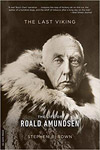
The Last Viking:
The Life of Roald Amundsen

Roald Amundsen's Sled Dogs:
The Sledge Dogs Who Helped Discover the South Pole
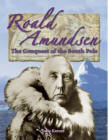
Roald Amundsen
The Quest for the South Pole, ages 9-12

The Amundsen Photographs
discovered in 1986, pictures from three of Amundsen's voyages
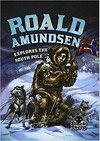
Roald Amundsen Explores the South Pole
ages 7-10
Robert Falcon Scott Books and Video

The Coldest March: Scott's Fatal Antarctic Expedition
by Susan Solomon
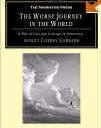
The Worst Journey in the World. Apsley Cherry-Garrard

The Voyage of the Discovery: Scott's First Antarctic Expedition
by Robert Falcon Scott, Ross MacPhee (Introduction), Fridtjof Nansen (Preface)

The Great White South: Travelling with Robert F. Scott's Doomed
South Pole Expedition by Herbert Ponting

Scott's Last Expedition: The Journals of Captain R.F.Scott

Edward Wilson's Antarctic Notebooks
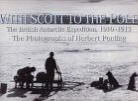
With Scott to the Pole
Herbert Ponting, illustrated

Discovery Illustrated: Pictures from Captain Scott's First Antarctic Expedition

Captain Scott by Sir Ranulph Fiennes

90 Degrees South: With Scott to the Antarctic (1933) DVD

History Chapters: Roald Amundsen and Robert Scott Race to the South Pole. Ages 4-8

Diary of the "Terra Nova" Expedition to the Antarctic, 1910-12

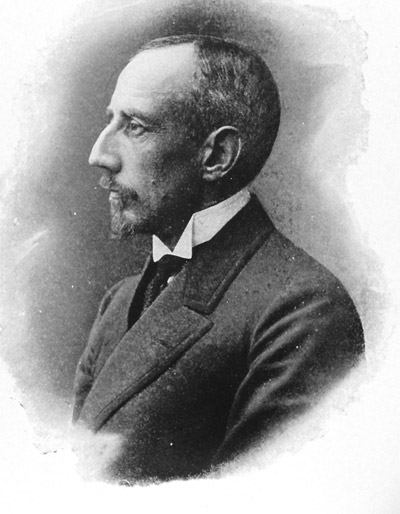
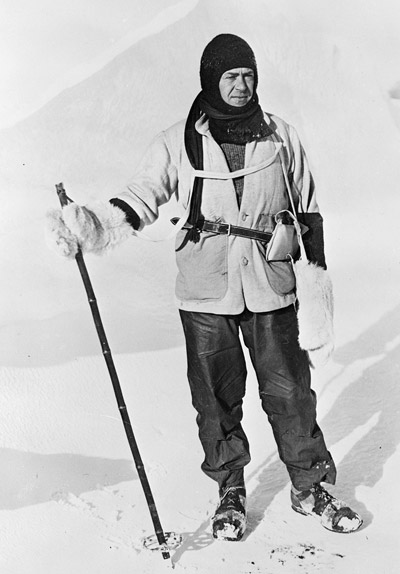
 Robert Falcon Scott, 1868 - 1912
Robert Falcon Scott, 1868 - 1912
